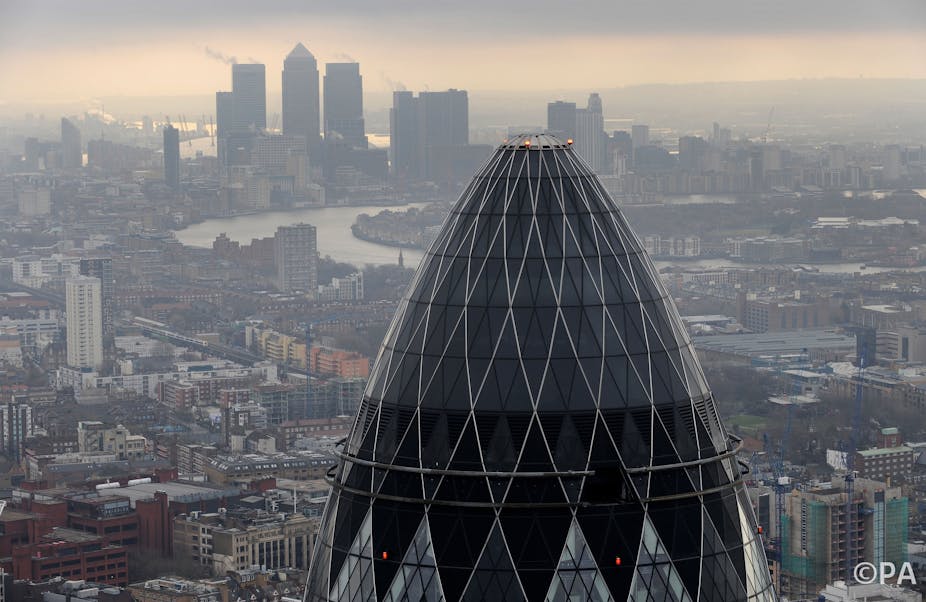Skyscrapers always provoke some extreme reactions, and the sale of London’s Gherkin as a result of the bankruptcy of one of its current owners is no exception. For a century, ever since the property explosions of New York and Chicago, the tall building has come to symbolise the best and the worst of the modern city, and of the economies that have produced it.
No wonder then that the Gherkin’s sale has been taken to be an illustration of the emptiness at the heart of rental driven capitalism. It prompts talk of the relationship between building high and economic slumps, and of a London dotted with empty skyscrapers. Like a J G Ballard story, or the reality of downtown Detroit, the image of a high rise with broken windows haunts every metropolis.

There has been a lot of hand-wringing about the shiny new city state that is sprouting under the rule of busy King Boris. Old London seems to be in danger of disappearing beneath a forest of new buildings, with hundreds more planned up and down the Thames. This is regulation lite, driven by property prices which make parking your money in glass and concrete a very attractive investment. Prince Charles’ complaints about the stubby developments of the 1980s, and their damaging of Canaletto’s views of St Paul’s cathedral, now look very moderate indeed.
The Romans claimed that whoever owns the land, eius est usque ad caelum et ad inferos – “it is theirs up to heaven and down to hell”. They couldn’t do a great deal to mine money from the air nonetheless, and it wasn’t until the invention of the steel frame and the elevator that architecture allowed anything much above six storeys. Imagine walking up all those flights of stairs and you will understand why the top rooms used to be the cheapest – bedrooms for servants or garrets for starving artists.

Less than 50 years separates the first skyscraper: Chicago’s Home Insurance Building at ten stories, from the Empire State at 102 stories. Rapid advances in construction, lighting and air conditioning meant that massive amounts of rentable space could be piled on top of each other. Huge architectural practices and general contractors co-ordinated gigantic assemblages of people and things, and new financial instruments were invented to spread risk on vast capital borrowings. Even demolition was speeded up, because old buildings needed to be cleared away quickly so that the steel could start rising.
So the skyscraper isn’t just a symbol of capitalism, it is capitalism materialised in steel and glass. It is a machine to extract rents from the skies, and the skylines of cities across the world are bar charts of property values. For many people, this is precisely the problem, as the tall building’s shadow turns streets into darkened canyons, and its arrogant erection demands that everyone pays attention.
The Shard, for example, is being endlessly condemned as a glassy one finger gesture at the rest of Old London Town, and the fact that it is still mostly empty is the subject of much gloating. It doesn’t tell us much in the long term though, since the Empire State was called the “Empty State” building for a long time, and didn’t start to make any money until 20 years after it was built.

The new shapes growing by the Thames are subject to just the same ambivalence. The names that some now have – Cheesegrater, Walkie Talkie, Lipstick and Gherkin – make them sound almost like children’s toys. But these “machines to make the land pay” (as Cass Gilbert, the architect of the Woolworth building put it) only get built if someone agrees to pay colossal rent and someone else can borrow towering piles of cash at less interest than the rent they receive. Without a financial architecture founded on big money – big profits to pay big rents – nothing much grows.
The sale of the Gherkin does not reflect a pin in the London property bubble, or a problem with the business model of the skyscraper. It just happened because some people borrowed too much, so they need to sell it – for around £650m – to some people with deeper pockets.
In a global economy where gigantic piles of cash get made, and need to find resting places, skyscrapers will continue to be built, and to be traded. That is what makes them so sublime, in Edmund Burke’s sense of being both terrifying and beautiful at the same time. They are both monuments to human ingenuity, and to massive inequality, as their occupants look down on the people living in cardboard on the city streets. The question they provoke is not really about boom or slump, but about the nature of an economic system which makes such projects possible.

